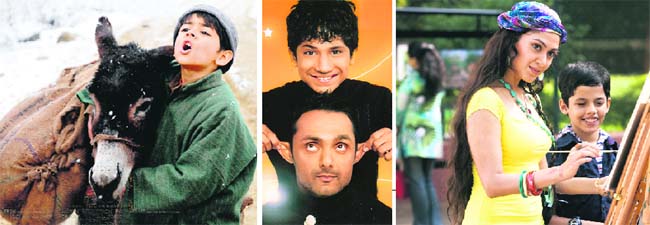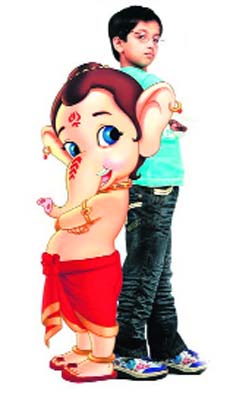|
No kid stuff
Bollywood has
churned out many films for and about children in the
four years since Taare Zameen Par changed the rules of
the game, but most of these efforts have failed to measure up,
writes Saibal Chatterjee
Aamir Khanís
directorial debut Taare Zameen Par was a runaway hit. In
the four years since the release of that film, the Mumbai movie
industry has come up with a larger complement of films about and
for children than it did in the entire decade that preceded its
making.
Since 2007, Indian
moviegoers have been treated to an assortment of films that have
sought to meet the growing demand for quality entertainment
among children and young adults. There has been a generous
sprinkling of animated mythological epics (Hanuman, Bal
Ganesh, My Friend Ganesha) amid a spate of live-action
features such as Nanhe Jaisalmer, Toonpur Ka Superhero,
Thanks Maa, Allah Ke Bandey, Satrangee Parachute, and Cycle
Kick.
Bollywood has also
delivered a few derivative efforts in the childrenís cinema
space Ė Chain Kulli Ki Main Kulli, Hari Puttar: A
Comedy of Terrors (based on an idea filched from Home
Alone) and Bumm Bumm Bole (inspired by Majid Majidiís
Iranian masterpiece, Children of Heaven). Whatís more,
we also recently saw a child superhero flick, Zokkomon,
starring Taare Zameen París Darsheel Safary in a new,
improved avatar.
So does this spate
of childrenís films from Mumbai represent a full-fledged
trend? The answer is yes, and no; yes because the frequency of
such films has certainly increased appreciably, and no, because
their boxoffice grosses havenít quite achieved the desired
levels. Hindi films for children still remain a fringe
phenomenon. One hit here and another one there do not a
revolution make. But, to focus on the positive side, at least a
beginning of what might be a clear phenomenon seems to have been
made.
Taare Zameen
Par, the story
of a child with dyslexia, a rarely understood learning disorder,
had the backing of a superstar. So the film arrived in our
multiplexes amid much fanfare. It tugged at our heartstrings,
marked the birth of a promising new child star and gave the
industry a reason to believe that narratives woven around
children and their growing-up woes could yield commercial
dividends. But all said and done, the boxoffice success of Taare
Zameen Par was a foregone conclusion. It is quite doubtful
that it would have achieved the profile it did, had Aamir Khan
not been on board.
Weeks after Taare
Zameen Par took the nation by storm, a small-budget film Apna
Asmaan about an autistic teenager (Dhruv Piyush Panjnani),
whose personal crises impacts the relationship of his parents
(played with characteristic competence by Irrfan Khan and
Shobhana), came and went without creating so much as a ripple.
The boxoffice
performance of the recently released Stanley Ka Dabba,
written and directed by Amole Gupte, is particularly heartening
because it is a film that carved a niche for itself despite
lacking star power. In Gupteís words, "It is a simple
story about children standing up for each other." The
simplicity of Stanley Ka Dabba stems primarily from its
steadfast focus on the unique world of children.
Gupte, who also
played a pivotal on-screen role in Stanley Ka Dabba, was
the writer of Taare Zameen Par as well.
Stanley Ka Dabba
is Gupteís riposte. It breaks the mould by eschewing artifice
at all levels ó the acting is fluid, the lighting is natural
and the film is shot with a small digital SLR camera that
allowed the child actors to be themselves. This touching but not
unduly dramatic tale of an orphan boy (Partho, Gupteís son),
who cannot afford to bring any food to school, is narrated with
the kind of grace and empathy that instantly sets the film apart
from the run-of-the-mill.
|

From left: Tahaan revolved around a young Kashmiri boy (Purav Bhandare) and his pet donkey;
Chain Kulli Ki Main Kulli was a cricket-themed drama about a 13-year-old orphan, who dreamt of becoming a cricketer;
and Manjari Phadnis and Darsheel Safary in Zokkomon. It is an action film
about a mistreated orphan, who bounces back in the guise of a superhero
|
Is the Indian
moviegoer finally ready, then, to embrace the kind of quality
childrenís cinema that Stanley Ka Dabba is? Once again,
we are in a whirlpool of ifs and buts. Stanley Ka Dabba
certainly isnít the first film of its kind to come out of
Mumbai. Fifteen years ago, ace cinematographer-director Santosh
Sivan made the wonderful Halo, about a motherless girl,
who loses her dog and sets out in search of the puppy, a search
that takes her across the city of Mumbai. Halo was a
deeply affecting blend of pathos, humour and innocence.
Sivan moved a few
notches higher with 2008ís Tahaan, which revolved
around a young Kashmiri boy (Purav Bhandare) and his pet donkey.
The boyís father has been missing for three years and he lives
with his grandfather (Victor Banerjee), mother (Sarika) and
elder sister (Sana Sheikh). His grandpa dies and the family is
plunged into a financial crisis. The donkey is taken away in
lieu of an unpaid debt. The young protagonist sets his heart
upon bringing his pet back, no matter what price he has to pay.
|

A still from My Friend Ganesha
|
Vishal Bhardwaj,
music composer and filmmaker, whose reputation today rests on a
bunch of star-driven dark thrillers, has remarkable childrenís
films like Makdee (2002) and The Blue Umbrella
(2007) to his credit. The former was a delectably inventive
fantasy about a wicked witch (played by Shabana Azmi), and a
pair of twin sisters as different from each other as chalk and
cheese. The latter, adapted from a Ruskin Bond story, was
another neatly crafted story of loss, reconciliation and self-realisation
woven around a young village girl, whose prized possession, a
blue umbrella, is stolen by a wily old shopkeeper.
Such was the
intrinsic quality of these films that it is surprising that they
did not achieve greater commercial success than they did. In an
ideal world, they would have triggered off a whole new trend of
childrenís cinema of high artistic value. The fact that the
Indian movie distribution and exhibition market is driven
entirely by the superstars was probably the reason why none of
these films got the sort of exposure that they deserved. We had
to wait until Taare Zameen Par to see a spurt in the
production of films aimed at children.
Bollywoodís
growing focus on the challenges of childhood has assumed
different forms. While Zokkomon is an action film about a
mistreated orphan, who bounces back in the guise of a superhero,
Chain Kulli Ki Main Kulli is a cricket-themed drama about
a 13-year-old boy, who lives in an orphanage and dreams of
becoming a cricketer, inspired by Kapil Devís exploits in the
1983 World Cup.
Faruk Kabirís
realistic Allah Ke Bandey focuses on two boys, who live
in one of Mumbaiís grimiest slums, and are inexorably sucked
into the underworld. In Irfan Kamalís unflinching Thanks
Maa, a Mumbai slum boy discovers an abandoned infant and
decides to find the mother and restore the baby to her. Cycle
Kick is about a boy, who is obsessed with making it big as a
footballer. Satrangee Parachute revolves around a boy and
his friends who flee their homes in Nainital and reach Mumbai in
search of the multi-hued parachute that they want to buy for one
of their pals.
Interesting enough
stories all, but sadly low on boxoffice draw. Even as the number
of childrenís films increases steadily and they move ever
closer to the Mumbai mainstream, their failure to find an
instant connect with the masses continues to be a
disappointment.
|